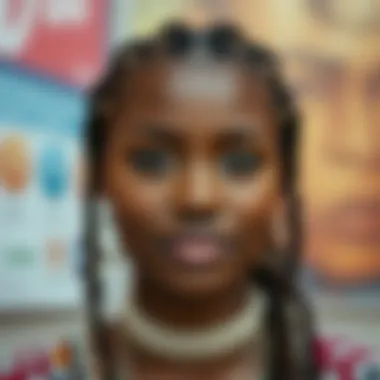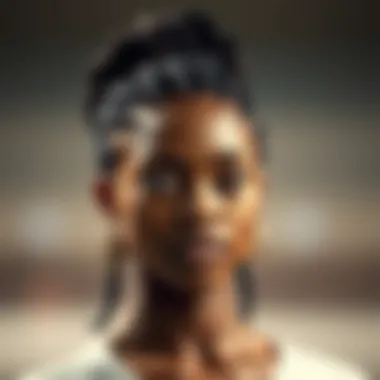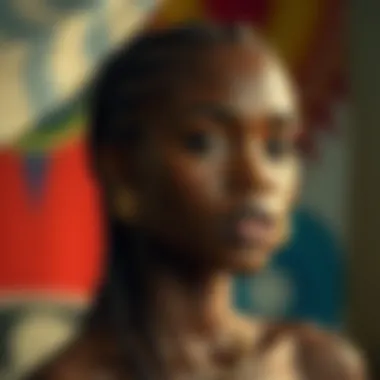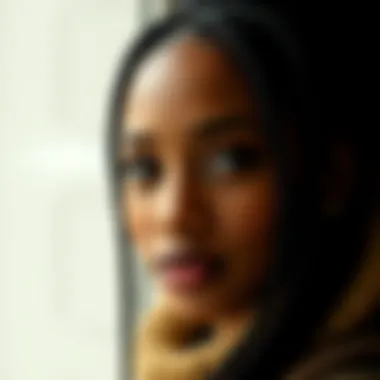Braided Hairstyles: Cultural Heritage in Black Communities


Intro
Braided hairstyles hold a significant place within Black communities, drawing from a rich tapestry of culture and history. These styles carry deep meanings, often serving as a means of self-expression and identity preservation. From intricate cornrows to delightful box braids, each stitch and twist narrates a story. The tradition of braiding is not only a beauty practice but a profound cultural marker that has withstood the test of time.
Understanding braided hairstyles goes beyond their aesthetic appeal; it connects to ancestry and heritage. Throughout history, braids have symbolized various statuses, roles, and even spiritual beliefs within African cultures. The art of braiding has been passed down through generations, with each style reflecting personal, family, and community identity.
As we explore this fascinating aspect of beauty culture, we will look at the techniques, styles, and the societal impact of braiding. You’ll gain insights into how these styles evolve and their relevance in contemporary society. From traditional techniques to modern adaptations, the story of braids continues to develop, fostering an even greater appreciation for these intricate artworks.
Preamble to Braided Hairstyles
Braided hairstyles hold a significant place in the world of hair fashion, particularly within Black communities. Beyond their aesthetic appeal, these styles carry layers of meaning that reflect personal and collective identity. Exploring braided hairstyles is akin to peeling back the layers of an onion, revealing rich histories, cultural ties, and innovations that have evolved over generations. The intricate artistry involved in braiding not only enhances beauty but also serves as a medium for self-expression and cultural pride.
Historical Context
The historical roots of braided hairstyles trace back to ancient times, playing a vital role in the everyday lives of African communities. Techniques for braiding can be found in the hieroglyphics of Egypt, where styles often indicated social status or tribe affiliation. For example, specific braiding patterns would be worn by officials or warriors, marking their positions in the societal hierarchy.
As Africans were forcibly dispersed across the globe during periods of colonization and slavery, these hairstyles remained a vital means of preserving cultural identity amid oppressive circumstances. The styles evolved as they were integrated into the diverse landscapes of the Americas and elsewhere. Notably, the tradition of braiding served as a silent form of resistance, allowing individuals to assert their identity in a society that sought to strip them of their heritage.
Reflecting on these rich historical connections is essential for understanding the ongoing significance of braided styles today. They are not merely hairstyles; they represent a lineage of resilience and cultural continuity.
Cultural Significance
Braided hairstyles also possess profound cultural significance in many Black communities, representing not only beauty but also a sense of belonging and identity. Different styles convey messages about one's lineage, community affiliations, and even personal milestones. For instance, in many cultures, the choice of a specific braid style for a child’s first birthday signifies a rite of passage, indicating a coming of age.
Social bonds are often strengthened through shared hairstyling experiences, where family and friends gather to braid hair in communal spaces. This tradition fosters an unspoken connection and camaraderie among participants, reinforcing the idea that beauty is a collective undertaking, deeply intertwined with cultural narratives.
Furthermore, braided hairstyles can serve as symbols of resistance and empowerment. In resistance movements, these styles are often worn by advocates of social change as a declaration of cultural pride. They remind the world of the importance of heritage and the stories woven into each strand of hair.
In summary, the cultural significance of braided hairstyles encompasses a rich tapestry of meaning—rooted in history yet flourishing in modern expressions of identity.
Techniques Behind Braiding
Braiding is much more than just an artistic display; it's a practice steeped in tradition and culture that intertwines various techniques and methods. The actual techniques behind braiding play a significant role in not only achieving diverse styles but also in preserving cultural heritage. Understanding these techniques opens up a world where creativity meets history.
Traditional Braiding Methods
Traditional methodologies in braiding have been handed down through generations within the Black communities, reflecting deep cultural roots and personal artistry. Some of the notable styles include:
- Three-Strand Braids: The backbone of most styles, three strands are intertwined skillfully. This classic braid can vary in thickness and tension, creating different looks from tight, defined sections to loose, bohemian waves.
- Feed-In Braids: An evolution of the basic braid, this method allows for seamless integration of additional hair strands to achieve thicker braids. It’s a technique that not only adds volume but also extends the lifespan of the style.
- Cornrows: A truly iconic method, cornrows involve braiding the hair close to the scalp in straight lines or intricate patterns. Each design can tell a story or symbolize status, while the method itself requires precise technique and skill.


The craftsmanship involved in these traditional methods provides a unique lens into the identity and heritage of individuals within Black communities. Mastering these techniques not only enhances versatility in styling but also fosters a sense of pride and connection among practitioners.
Modern Innovations in Braiding
As the world evolves, so does the art of braiding. Modern advancements have brought new techniques and styles to the forefront, leveraging technology and creativity:
- Use of Synthetic Hair: Innovations in materials have revolutionized how braids are perceived. Synthetic hair extensions like Kanekalon or Toyokalon offer a range of textures and colors, making it easier to achieve desired looks while maintaining hair health.
- Protective Styles: The shift towards more protective braiding styles caters to the needs of contemporary hair care, preventing damage and promoting growth. Styles like crochet braids and box braids are not only fashionable but also minimize stress on the scalp.
- Braiding Tools: Various tools have been introduced to simplify the braiding process, from rat-tail combs for sectioning to ergonomic styling grips that facilitate easier handling, especially during lengthy sessions.
Modern innovations have enriched braiding practices, making them accessible and trendy, without losing touch with their roots. It enables beauty enthusiasts to explore an array of possibilities, transforming each braid into a canvas expressing individuality while honoring tradition.
Modern braiding techniques maintain the essence of cultural heritage while paving the way for new expressions of identity. Each strand intricately linked represents not just style, but history.
Different Styles of Braids
The concept of braided hairstyles is as diverse as the individuals wearing them. Each style carries its own weight of significance, aesthetic appeal, and cultural resonance. Understanding the various styles of braids is essential because they reflect personal expression and cultural heritage in powerful ways.
Box Braids
Box braids are a staple in the realm of braided hairstyles. They are characterized by their square-shaped sections that create a distinct pattern, and they can be made with natural hair or extensions to add volume and length. One of the most lauded aspects of box braids is their versatility. They can be styled in countless ways—updos, half-up hairstyles, or simply worn loose. Moreover, these braids can last for several weeks, making them a practical option for many.
Aside from practicality, box braids also hold cultural significance. They can represent a person's status, community, or even personal journey. In some instances, they serve as a celebration of identity or heritage. For example, many young women might choose box braids as a rite of passage into adulthood, signaling a transition or personal growth. The ability play with colors and lengths makes them suitable for various occasions, enhancing their allure.
Cornrows
Cornrows, another renowned style, are often recognized for their intricate, raised braiding pattern closely woven into the scalp. This staple has deep ties to African heritage, where it has been worn for centuries. Beyond its historical context, cornrows allow for immense creativity. Whether adorned with beads or left simple, they can make powerful statements about cultural identity.
Cornrows are not just a hairstyle; they are an art form that requires skill and precision. It's common to see elaborate designs, with some individuals opting for geometric patterns or even symbols that hold personal importance. Maintenance of cornrows, however, is critical, as they can cause tension on the scalp if not cared for properly. However, when cared for, they can also last up to seven weeks, offering a chic yet low-maintenance option for many.
Fulani Braids
Originating from the Fulani or Fula people of West Africa, Fulani braids celebrate both beauty and tradition. These braids stand out for their unique styling that incorporates both intricate sections and often leaves a part of the hair free to hang down. This style often features center parts and is frequently embellished with beads or cowrie shells, enhancing its cultural artistry.
Wearing Fulani braids can signify connection to one's heritage, and many women choose this style to honor their roots or family background. It's also become a popular choice in contemporary fashion among both Black and non-Black individuals, broadening its reach well beyond its cultural origins. Like other braiding styles, they represent one's identity but specifically showcase an appreciation for the rich traditions from which they stem.
Twists
Twists bring their own flair to the world of braided styles. Unlike standard braids, twists involve intertwining two strands of hair to create a textured, rope-like appearance. This style is celebrated not only for its aesthetic but also for its ease of maintenance and adaptability. Twists can be short, long, or anywhere in between, making them a fitting choice for various lifestyles.
Much like other styles, twists can serve as an expression of identity and creativity. Some people opt for colorful braiding hair, while others might stick with natural shades. The flexibility of twists allows for various styles such as updos or loose hairstyles. In numerous Black communities, twists can embody personal style while connecting individuals to a larger cultural narrative surrounding natural hair.
Crochet Braids


Unlike the traditional methods of braiding, crochet braids employ a different technique that involves using a crochet hook to attach synthetic hair to natural hair. This method allows for a plethora of styles and textures, often resulting in fuller and more voluminous looks. The application technique has gained immense popularity for its relatively quick installation and the ability to achieve different looks without the commitment or time required of traditional braiding.
Generally, crochet braids give way to creativity, allowing wearers to explore various textures and colors. It caters to different hair types and can be customized to suit personal preferences, making it a favorite among many beauty enthusiasts. More than just a trendy hairstyle, crochet braids often provide a space for expression while being a nod to the evolving nature of hair care in modern society.
Overall, each style of braids serves more than a mere aesthetic purpose. They are imbued with meaning and cultural significance that bind us to our roots and express our individuality. Through these styles, one can tell stories of heritage and identity, showcasing the beauty woven into each strand.
Braids and Identity
The act of braiding hair transcends mere aesthetics. It embodies a rich tapestry of cultural expressions, personal narratives, and community ties. In Black communities, the significance of braided hairstyles runs deep, interwoven with identity in multiple layers of meaning. Braids serve as a visual language that communicates one’s heritage, beliefs, and social affiliations. By exploring how braids relate to identity, we tap into a fundamental aspect of self-expression that mirrors personal journeys and collective histories.
Personal and Community Identity
Braids act as a hallmark of individuality while simultaneously grounding individuals in their cultural roots. For many, wearing braids can evoke a sense of pride and belonging. Whether it’s the intricate patterns of cornrows or the bold statement of box braids, each style tells a story specific to the wearer’s journey.
Moreover, these styles can signify various aspects of community identity. For instance, the choice of braiding can connect people to their ancestry, and often, styles are passed down through generations. Just like a cherished heirloom, these hairstyles become a part of the family lore. As one wears a particular style, they not only embrace their own identity but also embody the shared history of those who came before them.
Additionally, braiding can have a powerful impact in social spaces. Wearing certain styles may foster connections among community members, creating a sense of unity. When individuals sport similar hairstyles at gatherings or events, it can serve as an unspoken bond that reinforces a collective identity.
Generational Connections
The threads of braiding weave together generations, linking the past with the present. There’s a rich narrative behind each style that relates to family traditions and personal memories. For many, learning the art of braiding from a parent or grandparent is more than just an activity; it’s a rite of passage. Such moments can become cherished family rituals, bridging the gap between the young and the seasoned.
It's common to find younger generations embracing the styles that their predecessors wore, creating cyclical trends that reflect evolving beauty standards while highlighting the power of tradition. Furthermore, these styles can evoke stories of resilience and strength, notions deeply embedded in the cultural psyche.
When someone sees a braid that resembles one worn by a beloved elder, it can spark conversations about heritage, struggles, and triumphs. This transmission of knowledge through braiding not only reinforces a personal identity but also propels community history forward.
"Braids are more than just a style. They are a map of our community journeys, intertwining the past, present, and future."
In exploring both personal and generational aspects of identity through braids, we unveil the profound connections that tie individuals to their cultural roots and encourage them to embrace their heritage with pride.
Braids in Popular Culture
Braided hairstyles, a significant aspect of Black culture, have found their way into various corners of popular culture, significantly influencing fashion, media, and societal perceptions. The representation and celebration of braids in contemporary settings not only showcase their aesthetic beauty but also highlight their deep-rooted cultural significance. This section addresses the vital role of braids in the modern zeitgeist, emphasizing how they are intertwined with identity, empowerment, and artistic expression.
Representation in Media
Media representation of braided styles is imperative for understanding their cultural relevance today. Over the years, television shows, films, and music videos have brought the beauty and artistry of braids into the mainstream. For instance, shows such as "Blackish" and films featuring Black protagonists often incorporate characters with braided hairstyles, affirming their importance within the narrative. These representations challenge the often Eurocentric beauty standards prevalent in mainstream media, providing a broader, more inclusive portrayal of beauty that resonates with viewers of all backgrounds.
Moreover, documentaries and articles that delve into the stories behind these hairstyles contribute to a better understanding of their emotional and cultural weight. The visibility of braids in media serves as a powerful tool for educating audiences about the history and significance of these styles, fostering respect and appreciation among diverse groups. However, this visibility also carries the responsibility of authenticity, as misrepresentation or simplification can lead to cultural appropriation, where individuals from outside the culture adopt these styles without acknowledging their roots and meanings.


"The representation of braided hairstyles in media acts as a mirror reflecting society’s evolving attitudes towards culture, identity, and beauty."
Influence of Celebrity Styles
The influence of celebrities on braided hairstyles is a powerful phenomenon that shapes trends and perceptions. Iconic figures such as Beyoncé, Solange, and Lupita Nyong’o have utilized their platforms to showcase braids, elevating them to the forefront of fashion conversations. Through their choices in hairstyles, these celebrities not only express personal identity but also reclaim and celebrate cultural heritage, encouraging fans to embrace their roots.
As styles evolve, celebrities often innovate with braiding techniques or incorporate them into larger beauty trends. For example, hair artists like Kim Kimble have emerged in the beauty industry, gaining prominence for their specialized braided hairstyles worn by A-list clients. This fusion of celebrity culture and braided styles creates a cycle of influence, where fans look to their favorite stars for inspiration.
Furthermore, social media platforms like Instagram and TikTok amplify these trends. Users can easily showcase their unique braided styles or recreate celebrity looks, fostering a community built on creativity and pride in Black hair textures. This not only enriches the cultural narrative surrounding braids but also gives individuals an outlet for self-expression, allowing them to curate their beauty journeys in a way that feels authentic.
Emphasizing this influence, the modeling of braids by high-profile figures acts as a form of resistance against prevailing stereotypes about Black hair, promoting the idea that beauty comes in all forms, textures, and styles.
In summary, the significance of braided hairstyles in popular culture is multifaceted. Media representation has broadened the understanding of these styles, while celebrity influence continuously redefines and celebrates their cultural roots. Braids serve as a canvas for identity, expression, and cultural pride, standing as a testament to the resilience and beauty of Black communities.
Care and Maintenance of Braided Hair
Caring for braided hair is more than just a routine; it’s about preserving the artistry and expression embedded in each strand. Braids, while striking and stylish, can also put unique demands on the hair and scalp. Hence, maintaining their health is pivotal not just for aesthetics but for the overall wellbeing of the hair. Neglect can lead to breakage, dryness, and even scalp issues, which may affect the integrity of the braids themselves. Therefore, understanding the products and practices involved in proper care is essential for anyone looking to enjoy their braided hairstyles long-term.
Products for Healthy Braids
To keep your braids looking pristine and your hair healthy, selecting the right products is crucial. Here are some staples that can elevate your hair care routine:
- Moisturizing Sprays: Utilizing a spray with aloe vera or coconut water keeps the hair hydrated. Hydration helps prevent frizz and promotes shine.
- Natural Oils: Oils such as jojoba, castor, or olive oil can be used sparingly to nourish both the scalp and the lengths of the braids. These oils can penetrate the hair shaft effectively, offering nourishment from within.
- Anti-Itch Scalp Treatments: Itching can be a common issue with braids. A soothing scalp treatment with tea tree oil can help alleviate discomfort without harsh chemicals.
- Lightweight Leave-In Conditioners: Using a leave-in conditioner that's lightweight ensures that hair remains soft without the weigh-down effect of heavier creams.
"A well-chosen product can make the difference between a good braid and a great one."
Routine Maintenance Practices
Keeping braids healthy involves more than just products; there are also various maintenance practices that need to be incorporated into your routine:
- Regular Cleansing: Washing your hair every couple of weeks with a gentle shampoo is vital. This helps to remove product buildup and dirt, which can affect scalp health.
- Scalp Massages: Incorporating regular scalp massages can stimulate blood flow, promoting healthy growth and relaxation.
- Avoiding Tension: When installing or redoing braids, it's fundamental to avoid styles that are overly tight. This reduces the risks of traction alopecia.
- Nighttime Protection: Using a satin or silk scarf while sleeping can help minimize friction, thus preserving the style while maintaining moisture.
- Hydrate from Within: Don’t forget about your diet. Drinking sufficient water and consuming vitamins that support hair health—like biotin and omega-3 fatty acids—will enhance the overall condition of your hair.
By intertwining these products and routines into your lifestyle, maintaining braided hairstyles can be an easy and fulfilling endeavor. This level of care not only ensures that the aesthetic remains but also that the hair beneath is cherished and protected.
End
The exploration of braided hairstyles reveals a rich history intertwined with cultural significance. This article illuminates how braiding is not merely a fashionable choice, but a profound expression of identity and heritage within Black communities. These hairstyles serve multifaceted purposes—ranging from aesthetic appeal to social statements, encapsulating personal narratives as well as collective memories.
The Lasting Impact of Braided Hairstyles
The impact of braided hairstyles transcends the realm of mere aesthetics; it resonates deeply within the soul of the community. The significance of these styles can be distilled into several essential elements:
- Cultural Heritage: Braiding connects individuals to their ancestry and cultural lineage. Many styles have origins in different African ethnic groups, each carrying unique meanings that relate to history, social status, and even marital status.
- Identity Expression: Choosing a particular braid style allows individuals to express their personal identity. This choice can reflect their mood, sense of style, or community belonging.
- Intergenerational Bonds: The passing down of braiding techniques and styles from one generation to the next fosters a sense of continuity and belonging. Grandmothers often teach their grandchildren how to braid, solidifying familial connections.
- Political Statement: In recent years, braided hairstyles have also become symbols of resistance against cultural appropriation and a celebration of Black beauty. Wearing natural or braided styles can serve as a powerful act of reclaiming one’s cultural identity in the face of societal pressures.
"Hair is the crown you never take off." This saying beautifully encapsulates how braided hairstyles function not just as an accessory but as an enduring emblem of culture and pride.
As braided hairstyles continue to evolve, they will undoubtedly adapt to modern sensibilities and shifts within society. However, their essence and the stories they tell will remain intact, ensuring that these sacred styles remain an essential part of the cultural fabric in Black communities. By understanding the lasting impact of these braids, one appreciates their role not only in personal identity but in societal narratives.







